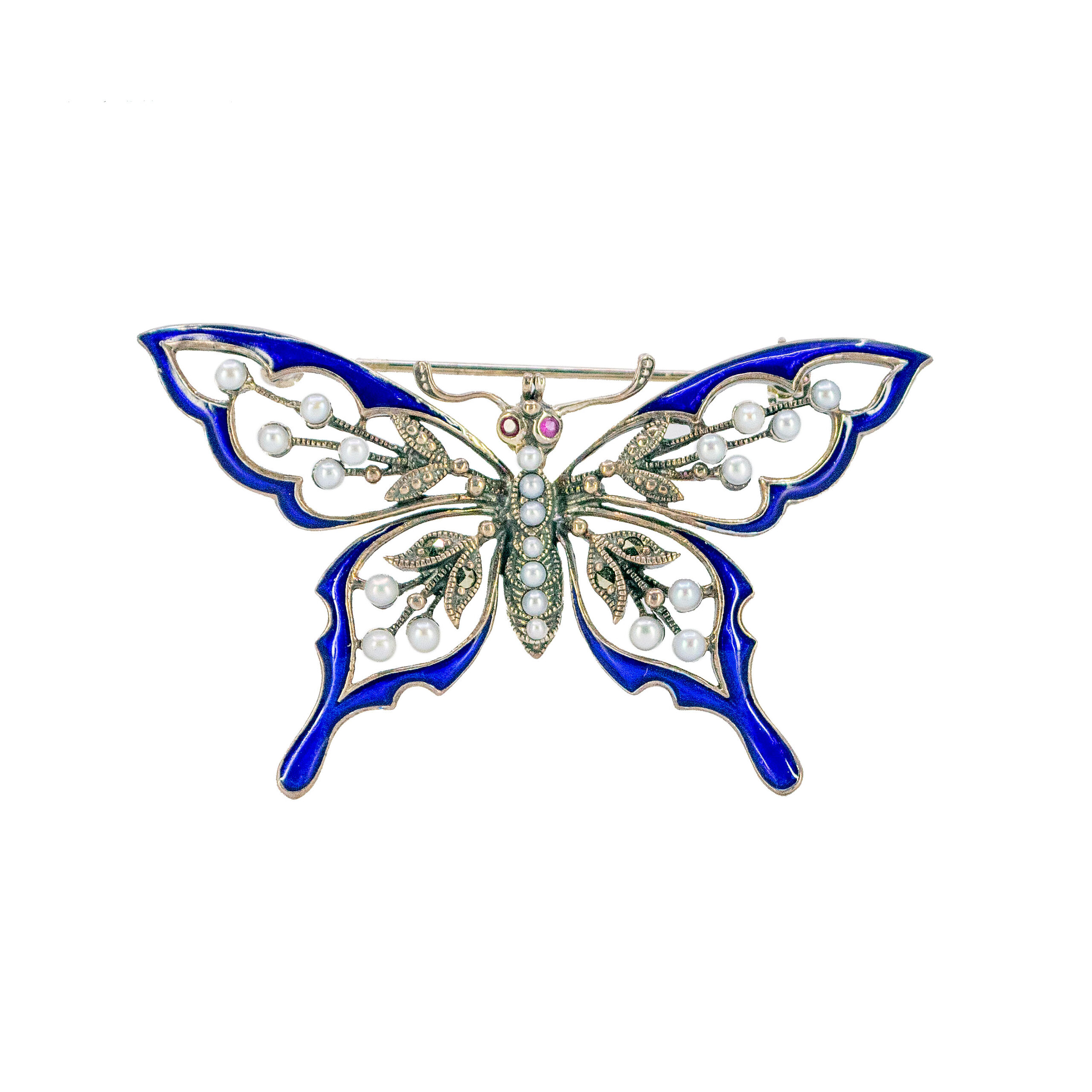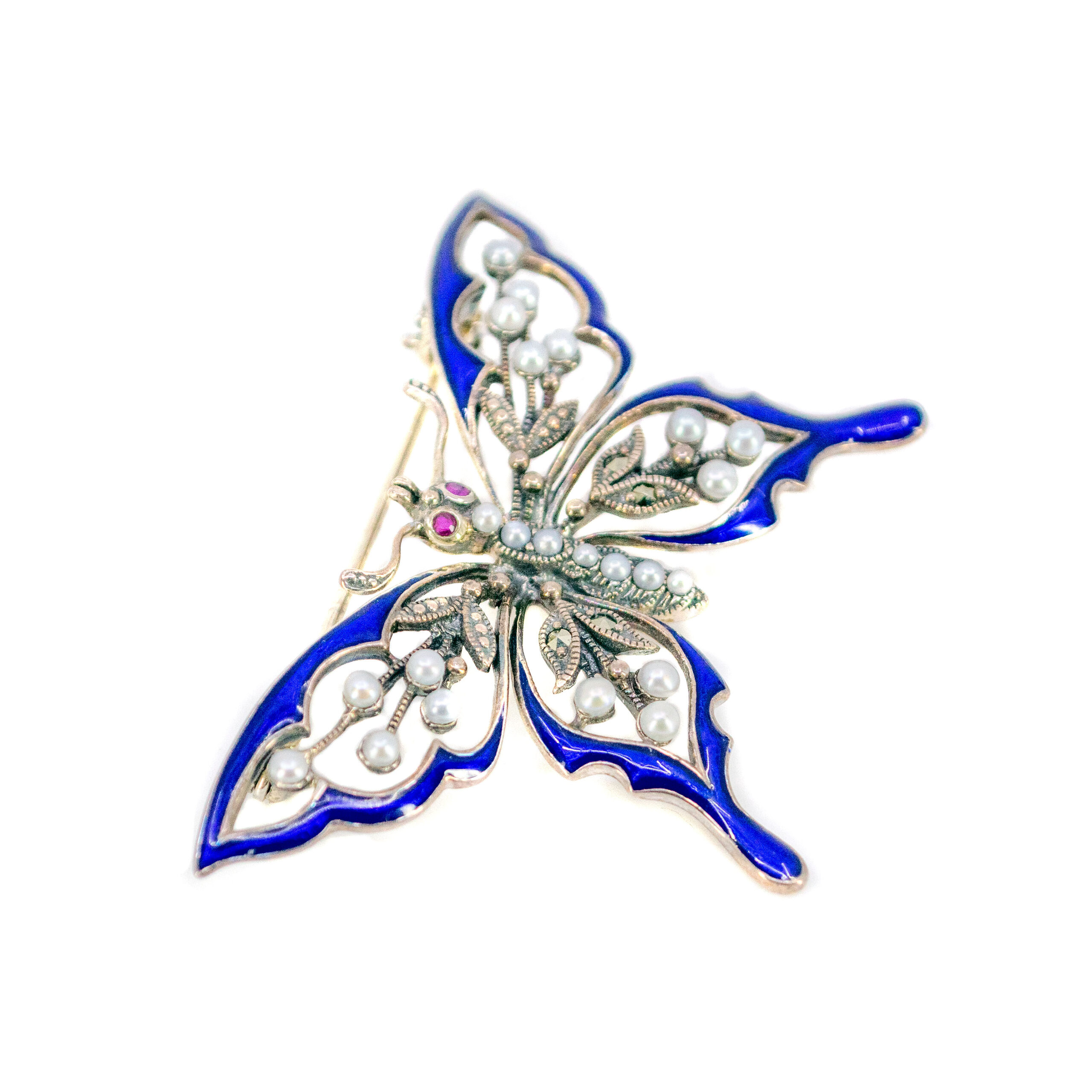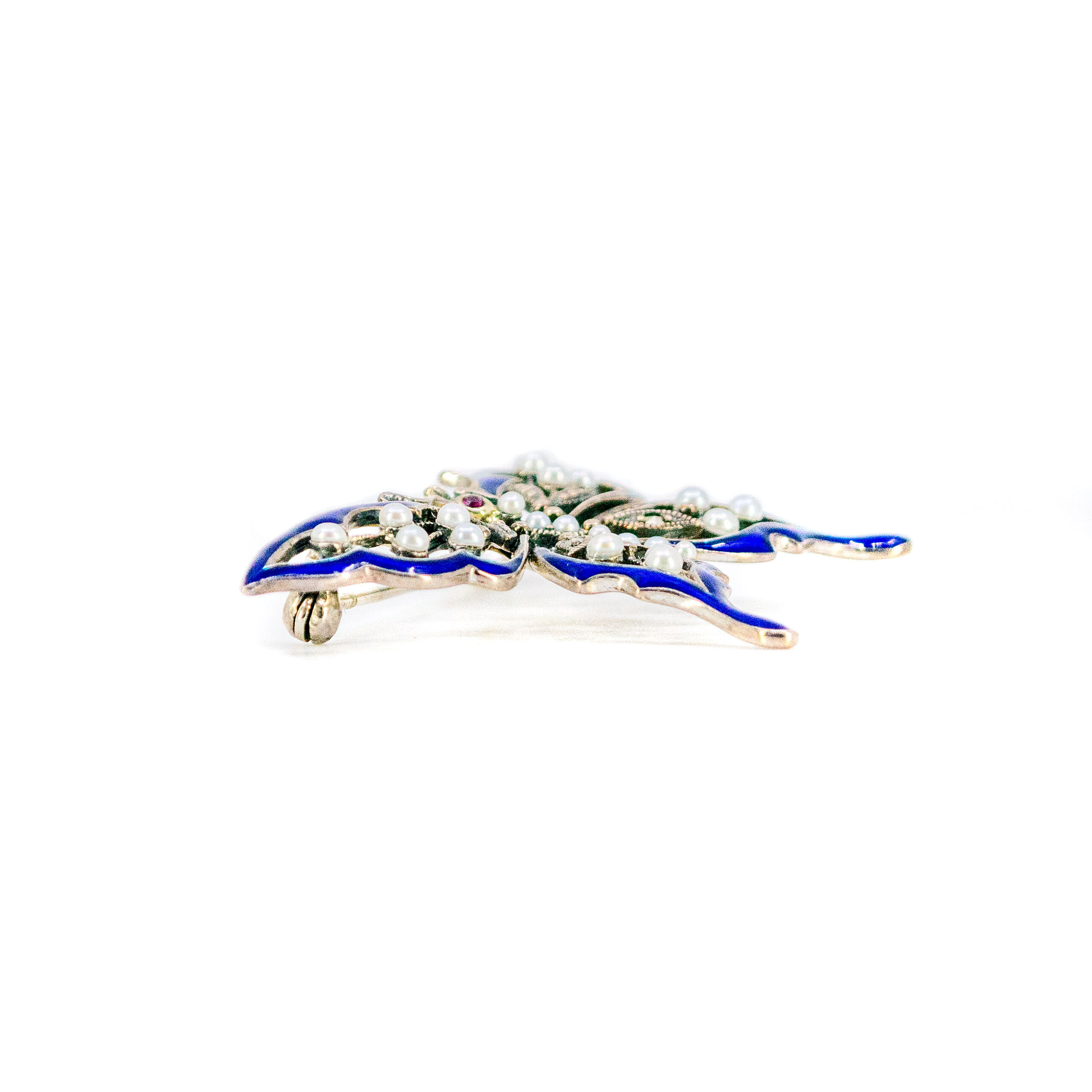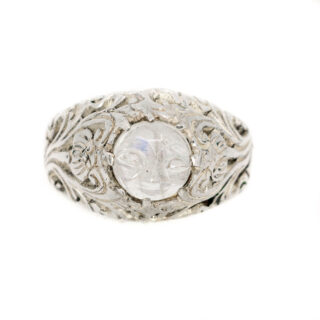This pretty contemporary butterfly brooch features pearl, ruby and enamel, beautifully crafted in 925′ Silver.
Details: Pearl, Ruby, Enamel, Silver Brooch.
Design Era: Contemporary.
Weight in grams: 5.5.
Condition: New.
Shipping and Pickup: This pretty piece ships from our store located in the center of Amsterdam, The Netherlands. We offer both registered shipping and local pickup at our store. In the case of local pickup, any applicable shipping costs will be refunded.
About Us: Add some sparkle to your style with Binenbaum.com. We offer a stunning selection of antique and vintage jewelry that you won’t find anywhere else. From timeless rings and dazzling necklaces to unique brooches, we have something for every taste and occasion. Visit our website today and treat yourself to a piece of history.
| Design Era | |
|---|---|
| Design & Historical Context | Contemporary jewellery is a type of jewellery that reflects current trends and styles, and is often made from a variety of materials beyond the traditional precious metals and stones. This allows contemporary jewellery to have a more modern and unique appearance compared to classic jewellery. To create contemporary jewellery, it is necessary to have both specialized training and a deep understanding of the subject. The contemporary style combines historical techniques and artistic expression with innovative ideas and materials, giving it a distinct personality that falls between fashionable mass-produced jewellery and traditional artisanal works of art. |
| Key Materials | |
| Materials & Craftsmanship | Pearl Pearls are small, round, and lustrous objects that are produced by certain types of mollusks, which are invertebrate animals that belong to the phylum Mollusca. Mollusks include a wide range of species, including oysters, clams, mussels, snails, and octopuses, among others. While all mollusks have the ability to produce pearls, only a few varieties are able to create gem-quality pearls that are suitable for use in jewelry. These include the oysters that produce akoya pearls, the freshwater mussels that produce freshwater pearls, and the South Sea and Tahitian pearls, which are produced by large saltwater oysters. Pearls are formed when an irritant, such as a grain of sand or a parasite, enters the mollusk and becomes trapped inside its shell. In response to the irritant, the mollusk secretes a substance called nacre, which coats the irritant and eventually forms a pearl. The quality of a pearl is determined by a number of factors, including its size, shape, color, and luster. High-quality pearls are prized for their beauty and are used in a variety of different types of jewelry, including necklaces, earrings, and bracelets. Ruby Ruby is a beautiful pink to blood-red colored gemstone that is a variety of the mineral corundum (aluminum oxide). The red color of ruby is caused mainly by the presence of the element chromium, which gives the stone its characteristic hue. The name "ruby" comes from the Latin word "ruber," which means "red." Ruby is one of the four precious stones, along with the sapphire, the emerald, and the diamond. It is highly prized for its beauty and is often used in a variety of different types of jewelry, including rings, earrings, pendants, and bracelets. Ruby is a very hard and durable gemstone, with a hardness of 9 on the Mohs scale (out of 10). It is resistant to scratches and other types of damage, which makes it a popular choice for use in jewelry. In addition to its use in jewelry, ruby is also believed to have various healing properties and is sometimes used in traditional medicine. It is thought to have calming and balancing effects, and is sometimes used in meditation practices. Enamel Enameling is a decoration technique in which a glass of certain composition is fused to the surrounding or under laying metal. Although the exact origins are unknown, the art of enamelling has been practiced since ancient times. The favor of adorning jewelry with bright colors has always existed and the use of glass created colors which nature – in the form of gemstones – could not provide for in ancient times. Excavations on Cyprus – in the Mediterranean – in the 1950's brought cloisonné enameled jewelry to the surface which dates from the 13th and 11th century BC. These are, to date, the earliest enameled items found in this particular technique. Silver Silver is a white metallic element that is known for its excellent conductivity of heat and electricity. It is represented on the periodic table of elements by the symbol Ag, and it is a member of the noble metals, which are known for their excellent resistance to oxidation. Silver is a relatively soft metal, with a hardness that is intermediate between gold and copper. It is more malleable and ductile than gold, which means that it can be easily shaped and molded into various forms. However, it is not as hard as copper, which means that it is more prone to scratches and other types of damage. Because of its softness, silver is usually alloyed with another metal to harden it enough to maintain the desired shape and details when it is used in jewelry and other decorative objects. This helps to give it the necessary strength and durability for use in these types of applications. Throughout history, silver has played a prominent role in the production of jewelry and objets d'art. It is prized for its beauty and versatility, and it is often used in a wide variety of different types of jewelry, including rings, earrings, pendants, and bracelets. It is also used in decorative objects, such as candlesticks, vases, and other decorative items. |
| Weight (in grams) | 5.5 |
| Condition |
Enhance the Beauty of Your Jewelry with Proper Care
Wearing your jewelry is a special way to express yourself and add a touch of personal style to any look. However, to ensure your jewelry remains in pristine condition, there are a few simple steps you need to take to keep it looking its best.
General Care Instructions:
Remove jewelry when showering or bathing, especially when at the beach, in the sea or in chlorinated water.
Avoid wearing jewelry while doing physical work such as housekeeping, gardening or exercise.
Storing your jewelry in a dry and cool place will help protect it from moisture, dirt and dust.
Keeping it away from harsh chemicals such as bleach, ammonia and chlorine will help to avoid discoloration and damage.
Cleaning your jewelry regularly with a soft cloth will help to keep it looking shiny and new.
Avoid exposing your jewelry to extreme temperatures, such as leaving it in direct sunlight or near a heater, as this can cause damage.
Handle your jewelry carefully and avoid dropping it, as this can cause the stones to loosen or the metals to scratch.
Finally, if possible, have your jewelry professionally checked and serviced. This will ensure that any potential problems are spotted and fixed before they become worse.
By following these tips, you can enjoy your precious jewelry for many years to come.
Related products
-
Quartz Silver Cameo Ring 12563-0623
€ 225,00 VAT incl. (where applicable) -
Marcasite (Pyrite) Silver Pendant Earrings 6232-0014
€ 250,00 VAT incl. (where applicable) -
Silver Floral Ring 11237-6981
€ 60,00 VAT incl. (where applicable) -
Pearl Turquoise Silver 9k Festoon Necklace 8303-2022
€ 1.295,00 VAT incl. (where applicable) -
Topaz Marcasite (Pyrite) Silver Rectangle-Shape Ring 11025-6877
€ 145,00 VAT incl. (where applicable) -
Silver Bullet Back Cufflinks 11241-6985
€ 195,00 VAT incl. (where applicable) -
Garnet Marcasite (Pyrite) Pearl Silver Ring 9670-6411
€ 265,00 VAT incl. (where applicable)
- Home
- Collection
- Fine Jewelry
- Silver Jewelry
- Silverware
- Boxes
- Candlesticks
- Salt and pepper shakers
- Miniatures
- Salt cellars
- Spoon Set
- Condiments
- Frames
- Napkin Ring
- Spoon
- Oddities
- Cups
- Vases
- Cutlery
- Serving Spoon And Cake Server
- Candlesticks
- Baskets
- Hanukkiah
- Spice Tower
- Yad
- Tea Set
- Sugar Castor
- Napkin Rings
- Wine Bottle Coaster
- Wine Stopper
- Tea Pot
- Jugs
- Rattles
- Hip Flask
- Miscellaneous
- Rings 💍
- About
- Contact
















